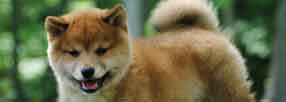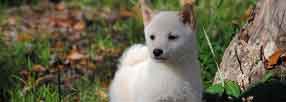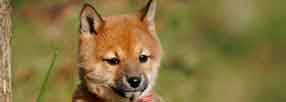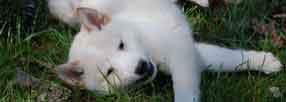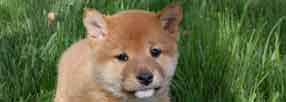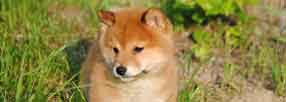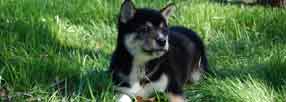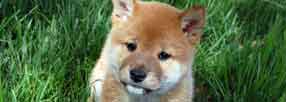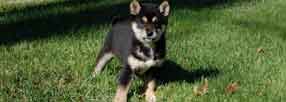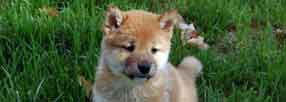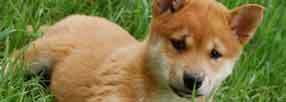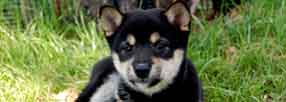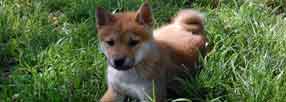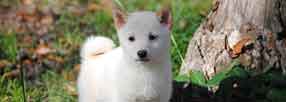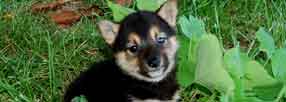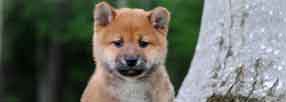|
|
About Shiba InusShiba Inu: "A Small Dog with a Big Attitude"In Japan the Shiba Inu is a small package weighing 15-25lbs. The coat is fairly short, harsh, plush, straight stand-off double. Colors are red, black and tan, red sesame, and cream. The Shiba is filled with a keen disposition and talent is generally compared to the Japanese Pepper. This term fits the Shiba Inu, spicy though small. Shiba OriginationShibas originated in the mountainous landlocked areas of Japan where the type has been known for nearly 3,000 years. Shibas were used as hunters of ground birds and small game. The Shiba is a result of interbreeding ancient types, the Sanin, the Mino, and the Shinshu. Modern breeders have combined the various types, selecting the desired qualities of small size, curled tail, triangular-set "Oriental" eyes, deep red color and affection for his owner. Shiba CharacterBecause of its native ability and enviroment, the modern Shiba enjoys the outdoors and cold weather. They have a special fascination for snow, playing and jumping in it. Agile and quick they delight in a good run. They are cat-like in their cleanliness and have a northern dog tendency of aloofness to strangers and an independent nature, being natural guardians. Although affectionate to their family. Shibas are sometimes scrappy with other dogs. Owners describe their cunning intelligence, saying they could charm a stone!! Shibas are spunkyProspective owners must understand the spitz-type personality before they will truly enjoy owning one. Shibas are perky and sturdy making them ideal childrens playmates. If there are no children around, nor adults they will adapt to playing with the family cat. Also a Shiba left alone is perfectly able to entertain himself for long periods. They are loving and ready for fun, but are not always underfoot when their people are busy. The Shiba has been the most popular dog in Japan for a number of years, where his size is welcome in a small country with a high population. Here in the USA they make perfect apartment pets. Shibas "love to live and live to love"Originally, Shibas were bred to flush birds and small game and were occasionally used to hunt wild boar. Now they are primarily kept as pets, both in Japan and the United States. There are more Shibas in Japan than any other breed. Around 7000 BC the ancestors of today's Shiba may have accompanied the earliest immigrants to Japan. Archaeological excavations of the shell-mounds left by the Jomonjin, or Rope-Pattern People (a name derived from the pattern found on their earthenware), show that they had small dogs in the 14 1/2 to 19 1/2 inch range. In the third century BC, a new group of immigrants brought their dogs to Japan. These dogs then interbred with the descendants of the Jomonjin dogs, and produced canines known to have pointed, erect ears and curly or sickle tails. In the 7th century AD, the Yamato Court established a dogkeeper's office that helps maintain the Japanese native breeds as an integral part of Japanese culture. Although the country was closed to foreigners from the 17th through 18th centuries, some European dogs and a breed known as the Chinese Chin were imported and crossed with native dogs living in the more populated areas. Dogs in the countryside, however, remained relatively pure. Originally there were three main varieties of Shiba; each named for its region of origin. Although similar, the Shibas from each area contributed to differences in breed type seen today. From the original Japanese native dogs, six distinct "breeds," in three different sizes developed. Name OriginThe small size dog has been called the Shiba since ancient times, with several theories surrounding the development of that name. One popular explanation is that the word Shiba means "brushwood," and the dogs were named for the brushwood bushes where they hunted. Another theory is that the fiery red color of the Shiba is the same as the autumn color of the brushwood leaves. A third conjecture is related to an obsolete meaning of the word shiba referring to its small size. These explanations are often combined and the Shiba is referred to as the "little brushwood dog." World War II nearly spelled disaster for the Shiba, and most of the dogs that did not perish in bombing raids succumbed to distemper during the post-war years. While the Mino and Sanin Shibas became practically extinct, more of the Shinshu Shibas survived. After the war, Shibas were brought from the remote countryside, and breeding programs were established. The remnants of the various bloodlines were combined to produce the breed as it is known today. |
|
|
|
© 2010-2016 Shiba-Puppies.com • All Rights Reserved • www.Shiba-Puppies.com Fair Use Notice: This site may contain copyrighted material whose use has not been specifically authorized by the copyright owners. We believe that this not-for-profit, educational use on the Web constitutes a fair use of the copyrighted material (as provided for in section 107 of the US Copyright Law). If you wish to use this copyrighted material for purposes of your own that go beyond fair use, you must obtain permission from the copyright owner. |
